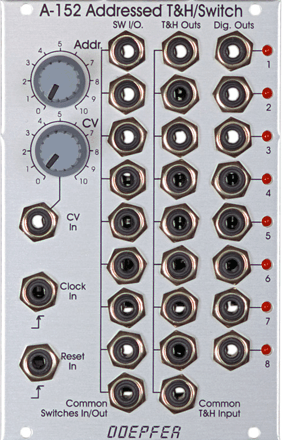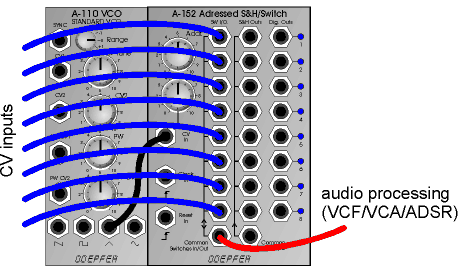A-152 Voltage
Addressed Track&Hold / Analog Shift Register (ASR)/
Octal Switch (Multiplexer)
http://navsmodularlab.blogspot.com/2008/11/patch-of-day-random-multiplexer.html
 |
A-152 ist ein vielseitig einsetzbares Schalter/Multiplexer und Mehrfach-Track&Hold-Modul (T&H). Es vereint einen spannungsadressierbaren elektronischer 8-fach-Drehschalter ("Multiplexer") und eine 8-fache T&H, die auch als eine Art analoges Schieberegister verwendet werden kann. Der momentan aktive Ein/Ausgang wird mit einer LED angezeigt. Zusätzlich sind 8 digitale Ausgänge (high/low) verfügbar.
Statt der Adressierung des aktiven Ein/Ausgangs über eine Steuerspannung, ist auch die Clock/Reset-Steuerung des Moduls in der Art eines Sequenzers möglich. Die steigende Flanke des Clock-Signals löst dabei das Fortschalten zur nächsten Stufe aus. Ein "high"-Pegel am Reset-Eingang setzt auf Stufe 1 zurück.
Grundsätzliche Arbeitsweise des Moduls:
Die Summe der Spannungen des manuellen Adress-Regler "Addr." und der
externen Steuerspannung "CV In", die mit dem Regler "CV"
abgeschwächt werden kann bestimmen die aktive Stufe (1...8) der drei
Untereinheiten Multiplexer, T&H und Digitalausgänge. Bei der Steuerung des
Moduls über Clock/Reset muss die anliegende Steuerspannung konstant bleiben, da
die Steuerspannung Priorität über die Clock/Reset-Steuerung hat (d.h. der
CV-Abschwächer muss auf Null gedreht oder das an "CV In"
angeschlossene Patch-Kabel abgezogen werden, und es darf nicht an dem
Adress-Regler gedreht werden).
Die Untereinheit 1 ist ein bidirektionaler 8-fach-Multiplexer (ein
elektronischer 8-fach-Drehschalter). Bidirektional bedeutet, dass die Einheit in
beide Richtungen - wie ein mechanischer Drehschalter - arbeitet. Der gemeinsame
Anschluss (Common Switches In/Out) und die Einzelanschlüsse (SW I/O) können
als Eingang oder Ausgang arbeiten. Werden die Einzelanschlüsse als Eingänge
benutzt (z.B. mit den Ausgängen verschiedener Modulationsquellen wie etwa LFO,
ADSR, Random usw. verbunden), so fungiert der gemeinsame Anschluss als Ausgang
und umgekehrt. Es können sowohl Steuerspannungsquellen als auch Audiosignale
geschaltet werden. Der schaltbare Spannungsbereich umfasst dabei den vollen
A-100-Spannungsbereich von -12V....+12V, d.h. es können alle im A-100
vorkommenden Spannungen ohne Einschränkungen geschaltet werden.
Die Untereinheit 2 ist die adressierbare 8-fach-T&H. Die am
gemeinsamen Eingang (Common T&H Input) anliegende Spannung wird auf den
momentan angewählten Ausgang (einer der acht T&H Outs) durchgeschaltet.
Sobald ein anderer Ausgang angewählt wird, wird an dem betreffenden Ausgang
zuletzt anliegende Spannung gehalten (Track&Hold-Funktion). Es kann hiermit
beispielsweise die "Toggling T&H"-Funktion des Buchla-Moduls 266
"Source of Uncertainty" realisiert werden, wobei hierfür jedoch nur
die ersten beiden T&H-Ausgänge benötigt werden. Diese Einheit kann auch
ähnlich einem analogen (Schiebe)-register
verwendet werden. Der Unterschied zu einem "echten" analogen
Schieberegister besteht darin, dass die Analogspannungen nicht an den nächsten
Ausgang weitergeschoben werden sondern dem betreffenden Ausgang fest zugeordnet
bleiben. In einigen Anwendungsfällen ist das Resultat jedoch das gleiche (wenn
man beispielsweise die Tonhöhen von 3 VCOs mit 3 Ausgängen des A-152 steuert).
Die Untereinheit 3 ist die Digitalausgang-Sektion. Der digitale Ausgang
der momentan gewählten Stufe ist "high", alle anderen
"low". Die Digitalausgänge können beispielsweise zur Triggerung von
Hüllkurvengeneratoren oder zur Verringerung
der anwählbaren Stufen im geclockten Modus verwendet werden, indem einer der
Digitalausgänge mit dem Reset-Eingang verbunden wird.
Hinweis: Im Unterschied zur Sample&Hold-Schaltung (siehe S&H A-148) folgt bei T&H die Ausgangsspannung der Eingangsspannung, solange die T&H-Stufe (1...8) aktiviert ist. Erst beim deaktivieren der T&H-Stufe wird die letzte anliegende Spannung gehalten.
Hinweis: Das am Clock-Eingang angelegte Signal muss bezüglich des A-100-Systems, in dem sich der A-152 befindet, massebezogen sein. Der Grund hierfür ist eine Erkennungsschaltung am Clock-Eingang, mit der festgestellt wird, ob ein Clock-Signal zugeführt wird oder ob das Modul spannungsgesteuert arbeitet. Hierzu wird der Masse-Anschluss der Clock In-Buchse verwendet. Wird hier ein Clock-Signal von außen (d.h. nicht von einem Modul, das ebenfalls im A-100-Rahmen sitzt) zugeführt, fehlt der Massebezug und die Erkennungsschaltung am Clock-Eingang funktioniert nicht (d.h. der Clock-Eingang arbeitet nicht). Abhilfe schafft irgendein zweites Kabel zwischen den beiden System, da dann hierüber die Masseverbindung der beiden Systeme hergestellt wird.
Die deutsche Bedienungsanleitung ist als PDF-Datei auf unserer Website verfügbar: A152_Anl.pdf.
Technischer Hinweis: Um die elektronischen Schalter der Schalter-Einheit (linke Buchsenreihe) im Falle eines fehlerhaften Patches (z.B. Verbindung zweier Ausgänge) zu schützen, befindet sich ein 1k-Schutzwiderstand in jeder O/I-Leitung. Bei der Übertragung von CV-Spannungen für VCOs kann es daher zu sehr kleinen Spannungsabfällen kommen, die sich jedoch hörbar auf die Tonhöhe auswirken können. Daher sollten bei der Übertragung von CV-Signalen für VCOs Puffer zwischengeschaltet werden (z.B. A-180-3, A-180-4 oder der Precision Adder A-185-2). Der Einbau der Puffer in das Modul A-152 ist nicht möglich, da dann die Bidirektionalität nicht mehr gegeben ist.
Der gemeinsame T&H-Eingang kann mit Hilfe
einer Steckbrücke auf den gemeinsamen Multiplexer-Anschluss normalisiert werden,
d.h. sofern in die Buchse "Common T&H Input" kein Kabel
eingesteckt wird, ist der Anschluss mit dem gemeinsamen Multiplexer-Anschluss
"Common Switches In/Out" verbunden. Dies ermöglicht eine
gemultiplexte T&H-Funktion, d.h. jedem der T&H-Ausgänge kann ein
eigenes Signal für die T&H-Funktion zugeordnet werden.
Es ist auch möglich die T&H-Einheit dahingehend zu modifizieren, dass die
Ausgänge S&H-Funktion statt T&H-Hold bekommen. Bei S&H
(Sample&Hold) wird der momentan am gemeinsamen Eingang anliegende
Spannungswert beim Adresswechsel sofort übernommen. Track&Hold ist
ähnlich, jedoch folgt hier der Ausgang der Eingangsspannung, solange der
betreffende Ausgang angewählt ist und übernimmt den Wert erst beim Wechsel auf
eine andere Adresse. Die Modifikation ist auf der A-100
DIY-Seite beschrieben (nur in Englisch verfügbar).
Technischer Hinweis: Die T&H-Funktion wird rein analog mit Hilfe eines elektronischen Schalters gefolgt von einem Haltekondensator mit Pufferschaltung realisiert. Die Spannung am Ausgang driftet in der Haltephase, da sich der Kondensator allmählich über parasitäre Widerstände entlädt. Die Drift liegt bei typ. 200mV/Minute, hängt aber zusätzlich von mehreren Faktoren ab (z.B. Bauteile-Toleranzen, Luftfeuchtigkeit, Temperatur). Für das Halten von CV-Signalen, die zur Tonhöhensteuerung von VCOs verwendet werden, ist das Modul daher nur bedingt geeignet (nur für kurze Zeiten).
 |
Module A152 is a very useful switching and T&H module. It combines a voltage addressed 1-to-8 multiplexer and 8 fold
T&H that can be used as kind of an analog shift register too. The active in/output is displayed by a LED. The digital output of the
currently addressed step outputs "high". The remaining digital outputs
are low.
Instead of voltage control even clock/reset controlled addressing of the active
step is possible. The rising edge of each clock signal causes an advance to the
next state. The rising edge of the reset signal resets to step 1.
Basis principles: The sum of the voltages coming
from the manual Address control and the CV input define the currently addressed
step of the 3 sub-devices. If the module is controlled by clock and
reset the control voltage has to remain unchanged as the CV control has priority
over the clock/reset control (e.g. simply turn the CV control fully
counterclockwise and do not touch the Address control knob).
Sub-device #1 is the bidirectional 8-fold multiplexer (kind of an electronical 8-fold
rotary switch). Bidirectional means that it works into both directions like a
mechanical rotary switch: the common socket may work as an output that is
connected to one of the 8 inputs that are e.g. connected to modulation or audio
sources. But the common socket may even function as input. In this case the
signal applied to the common socket is output to the currently addressed single
socket. The voltage range of the in/outputs to be switched is the full A-100
voltage range -12V....+12V. All A-100 signals can be switched without any
restrictions.
Sub-device #2 is the addressed 8-fold T&H. The signal at the common
T&H input
is connected to the addressed T&H output. As soon as a new output is
addressed the last voltage is stored at the output (Track&Hold function). The
T&H section of the A-152 allows the emulation of the "toggling T&H" function of the Buchla module 266 "Source of
Uncertainty". Only the first two T&H outputs of the A-152 are required
for this application. This unit can be used also as kind of an analog
(shift) register. The difference to a
"real" analog shift register is that the sampled output voltages are
not shifted to the next output but remain allocated to the same output. But in
some cases (e.g. controlling the pitch of 3 VCOs by 3 output voltages of the
A-152) the result is the same.
Sub-device #3 is the digital output section. The digital output of the currently
addressed turns to "high". All other digital outputs are low. The
digital outputs can be used to trigger e.g. envelope generators or to control the reset input in the clocked mode to
reduce the number of addressed stages.
Remark: In contrast to the Sample&Hold (see S&H A-148) the output voltage follows (i.e. tracks) to the input voltage as long as the corresponding stage (1...8) is active. Just when the stage is deselected the last voltage is held.
Remark: The clock signal that is fed into the Clock In socket has to be GND referenced to the A-100 frame. The reason for this is a recognition circuit at the clock input that is used to decide if the module is clock controlled or voltage controlled. For this recognition the GND pin of the Clock In socket is used. If an external clock signal is used (i.e. not coming from a module mounted into the A-100 frame where the A-152 is mounted) the GND reference is missing and the recognition circuit does not work (with the result that the clock input does not work). But there is a simple workaround: as soon as both systems are connected by means of any other patch cable that way the GND reference is established.
For more detailed information please look at the English user's manual: A152_man.pdf
Technical note: To protect the electronic switches in case of an unsuitable patch (e.g. connection of two outputs) a 1k protection resistor is inserted into the O/I line of each switch of the switching unit (left socket row). If control voltages used for VCOs are switched this may cause a small voltage drop and lead to undesired audible detuning. For this application we recommend to insert a CV buffer between A-150-8 and the VCO(s), e.g. A-180-3, A-180-4 or the Precision Adder A-185-2. Integrating the buffers into the module A-152 is not possible because this would ruin the bidirectionality of the switches.
The "Common T&H Input" socket
can be normalled by jumpers to the "Common Switches In/Out" socket, i.e. the
common T&H input is connected to the common switches In/out socket as long
as no plug is inserted to the "Common T&H Input". This allows a
multiplexed T&H, i.e. each T&H output has a separate signal to be
sampled.
It is also possible to modify the T&H outputs for S&H function. If
S&H (Sample&Hold) is chosen the voltage applied to the common input is
sampled immediately when the output in question is adressed. T&H
(Track&Hold) is similar but in this case the output follows the input as
long as the output in question is addressed. The voltage is stored not until
another output is selected. The modifiation is described on the A-100
DIY page.
Technical note: The T&H function is realized by pure analog circuitry (electronic switch followed by a holding capacitor and buffer). Consequently the output voltage drifts a bit in the holding state because the capacitor is discharged by parasitic resistors. The drift is about 200mV/minute but depends upon different conditions (e.g. humidity, temperature, tolerances of the electronic parts). For the storage of control voltages over a longer time used to control the pitch of a VCO the module is suitable to only a limited extent.
Tiefe/Depth: 45 mm (gemessen ab der Rückseite der Frontplatte / measured from the rear side of the front panel)
Strombedarf/Current: +40mA (+12V) / -20mA (-12V)
The price in US$ depends upon the exchange rate between Euro and US$ at the payment day.


